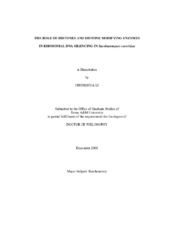| dc.description.abstract | In S. cerevisiae, the ribosomal DNA locus is silent for RNA polymerase II (Pol
II) transcription and recombination (rDNA silencing). Our goal is to understand how
histones and histone-modifying enzymes regulate the silent chromatin at the rDNA
locus.
Sir2, a NAD+-dependent histone deacetylase, is required for rDNA silencing. To
understand how Sir2 regulates rDNA silencing, we performed chromatin
immunoprecipitation to measure the association of modified histones across the rDNA
repeat in wild-type and sir2Δ cells. We found that in sir2Δ cells, histone H3 at the rDNA
became hyperacetylated and hypermethylated. High levels of K4-methylated H3
correlate with Pol II transcription. Consistent with this, we found that the nontranscribed
spacer (NTS) region was transcribed by Pol II in sir2Δ cells. To investigate if
transcription of the NTS region regulates rDNA silencing, we overexpressed this region
both in trans and in cis. Our data showed that overexpression of the NTS region in cis
caused Pol II silencing defect and hyperrecombination at the rDNA. These data suggest
that Sir2 contributes to maintain the silent chromatin at the rDNA by repressing Pol II transcription in the NTS region. We also found that the NTS transcripts could be
translated in vitro and that they copurified with polysomes, suggesting that the
transcripts may encode proteins or that the transcripts are somehow involved in the
process of translation.
Additionally, we examined the role of linker histone H1 in regulating rDNA
silencing. We found that, unlike Sir2 that represses both Pol II transcription and
recombination, histone H1 only represses recombination at the rDNA. The
hyperrecombination defect at the rDNA is more severe in sir2Δ hho1Δ double mutant
than in either single mutant, suggesting histone H1 and Sir2 act independently.
Consistently, hho1Δ cells did not accumulate extrachromosomal rDNA circles (ERCs) or
the Holliday junction intermediates, which accumulate in sir2Δ cells. These data suggest
that histone H1 and Sir2 regulate different recombination pathways.
In summary, my research has provided insight into the mechanism of how silent
chromatin at the rDNA locus is regulated, which will help us understand how
fundamental components of chromosomes affect gene expression and genome stability. | en |


